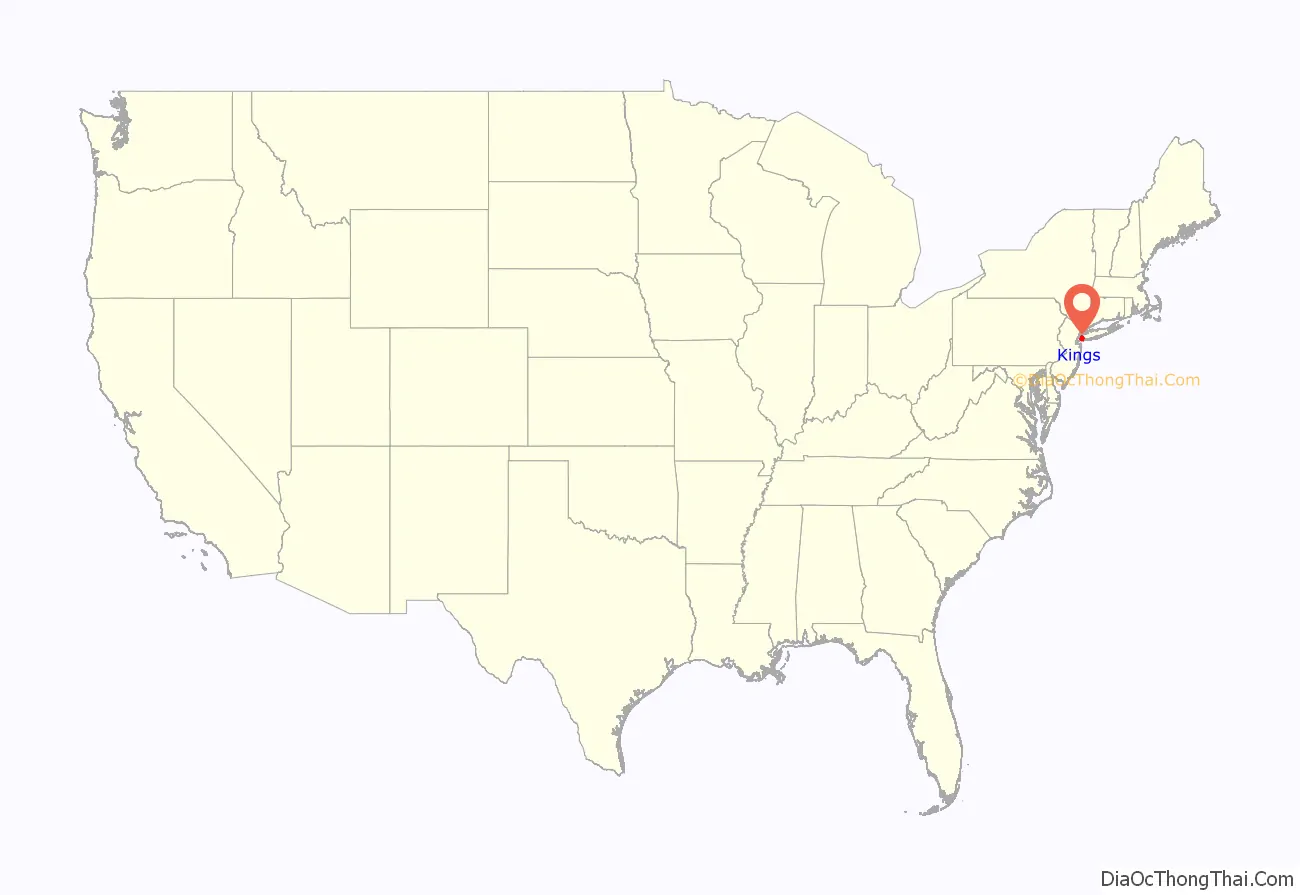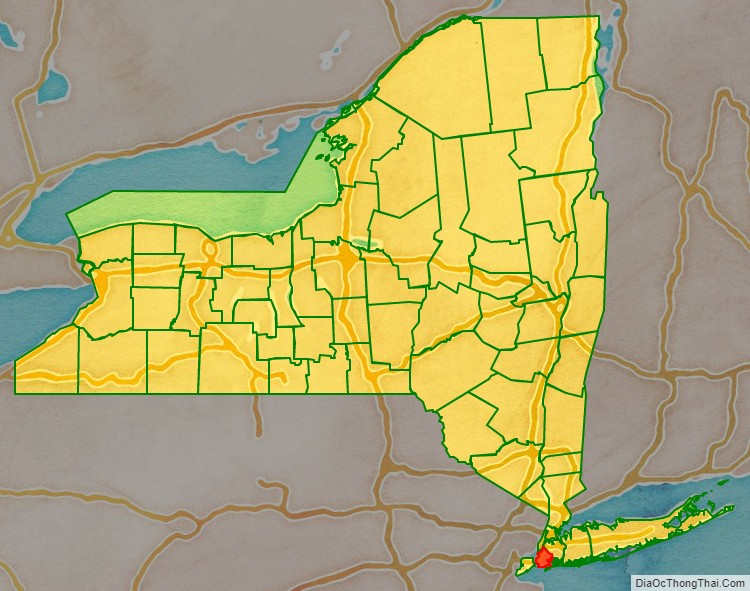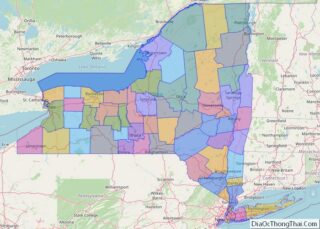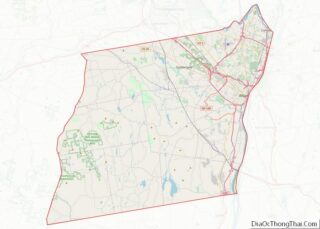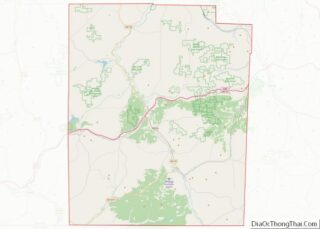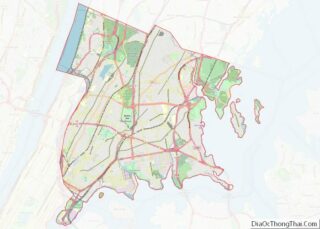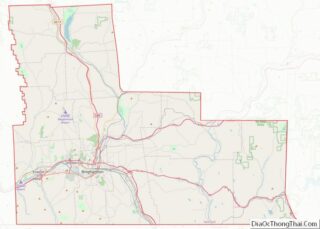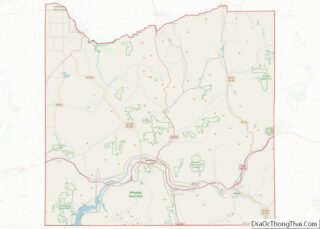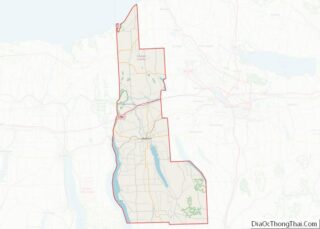Brooklyn (/ˈbrʊklɪn/) is a borough of New York City, coextensive with Kings County, in the U.S. state of New York. Kings County is the most populous county in the State of New York, and the second-most densely populated county in the United States, behind New York County (Manhattan). Brooklyn is also New York City’s most populous borough, with 2,736,074 residents in 2020.
Named after the Dutch town of Breukelen, Brooklyn is located on the westernmost edge of Long Island and shares a border with the borough of Queens. It has several bridge and tunnel connections to the borough of Manhattan, across the East River, and is connected to Staten Island by way of the Verrazzano-Narrows Bridge. With a land area of 70.82 square miles (183.4 km) and a water area of 26 square miles (67 km), Kings County is the state of New York’s fourth-smallest county by land area and third-smallest by total area.
Brooklyn was founded by the Dutch in the 17th century and grew into a busy port city by the 19th century. On January 1, 1898, after a long political campaign and public relations battle during the 1890s, in accordance to the new Municipal Charter of “Greater New York”, Brooklyn was consolidated in and annexed (along with other areas) to form the current five borough structure of New York City. The borough continues to maintain some distinct culture. Many Brooklyn neighborhoods are ethnic enclaves. Having a larger Jewish population than Jerusalem, the borough has been described as “the most Jewish spot on Earth”, with Jews forming around a quarter of its population. Brooklyn’s official motto, displayed on the Borough seal and flag, is Eendraght Maeckt Maght, which translates from early modern Dutch as “Unity makes strength.”
In the first decades of the 21st century, Brooklyn has experienced a renaissance as a destination for hipsters, with concomitant gentrification, dramatic house price increases, and a decrease in housing affordability. Some new developments are required to include affordable housing units. Since the 2010s, parts of Brooklyn have evolved into a hub of entrepreneurship, high technology start-up firms, postmodern art and design.
| Name: | Kings County |
|---|---|
| FIPS code: | 36-047 |
| State: | New York |
| Founded: | 1683 |
| Named for: | Breukelen, Netherlands |
| Seat: | none (sui generis) |
| Total Area: | 97 sq mi (250 km²) |
| Land Area: | 70.82 sq mi (183.4 km²) |
| Total Population: | 2,736,074 |
| Population Density: | 38,634/sq mi (14,917/km²) |
| Website: | www.brooklyn-usa.org |
Kings County location map. Where is Kings County?
History
The history of European settlement in Brooklyn spans more than 350 years. The settlement began in the 17th century as the small Dutch-founded town of “Breuckelen” on the East River shore of Long Island, grew to be a sizeable city in the 19th century and was consolidated in 1898 with New York City (then confined to Manhattan and the Bronx), the remaining rural areas of Kings County, and the largely rural areas of Queens and Staten Island, to form the modern City of New York.
Colonial era
The Dutch were the first Europeans to settle Long Island’s western edge, which was then largely inhabited by the Lenape, an Algonquian-speaking American Indian tribe often referred to in European documents by a variation of the place name “Canarsie”. Bands were associated with place names, but the colonists thought their names represented different tribes. The Breuckelen settlement was named after Breukelen in the Netherlands; it was part of New Netherland. The Dutch West India Company lost little time in chartering the six original parishes (listed here by their later English town names): Gravesend: in 1645, settled under Dutch patent by English followers of Anabaptist Deborah Moody, named for ‘s-Gravenzande, Netherlands, or Gravesend, England; Brooklyn Heights: as Breuckelen in 1646, after the town now spelled Breukelen, Netherlands. Breuckelen was along Fulton Street (now Fulton Mall) between Hoyt Street and Smith Street (according to H. Stiles and P. Ross). Brooklyn Heights, or Clover Hill, is where the village of Brooklyn was founded in 1816; Flatlands: as Nieuw Amersfoort in 1647; Flatbush: as Midwout in 1652; Nieuw Utrecht in 1652, after the city of Utrecht, Netherlands; and Bushwick: as Boswijck in 1661.
The colony’s capital of New Amsterdam, across the East River, obtained its charter in 1653. The neighborhood of Marine Park was home to North America’s first tide mill. It was built by the Dutch, and the foundation can be seen today. But the area was not formally settled as a town. Many incidents and documents relating to this period are in Gabriel Furman’s 1824 compilation.
Present-day Brooklyn left Dutch hands after the English captured the New Netherland colony in 1664, a prelude to the Second Anglo-Dutch War. New Netherland was taken in a naval action, and the English renamed the new capture for their naval commander, James, Duke of York, brother of the then monarch King Charles II and future king himself as King James II. Brooklyn became a part of the West Riding of York Shire in the Province of New York, one of the Middle Colonies of nascent British America.
On November 1, 1683, Kings County was partitioned from the West Riding of York Shire, containing the six old Dutch towns on southwestern Long Island, as one of the “original twelve counties”. This tract of land was recognized as a political entity for the first time, and the municipal groundwork was laid for a later expansive idea of a Brooklyn identity.
Lacking the patroon and tenant farmer system established along the Hudson River Valley, this agricultural county unusually came to have one of the highest percentages of slaves among the population in the “Original Thirteen Colonies” along the Atlantic Ocean eastern coast of North America.
On August 27, 1776, the Battle of Long Island (also known as the ‘Battle of Brooklyn’) was fought, the first major engagement fought in the American Revolutionary War after independence was declared, and the largest of the entire conflict. British troops forced Continental Army troops under George Washington off the heights near the modern sites of Green-Wood Cemetery, Prospect Park, and Grand Army Plaza.
Washington, viewing particularly fierce fighting at the Gowanus Creek and Old Stone House from atop a hill near the west end of present-day Atlantic Avenue, was reported to have emotionally exclaimed: “What brave men I must this day lose!”.
The fortified American positions at Brooklyn Heights consequently became untenable and were evacuated a few days later, leaving the British in control of New York Harbor. While Washington’s defeat on the battlefield cast early doubts on his ability as the commander, the tactical withdrawal of all his troops and supplies across the East River in a single night is now seen by historians as one of his most brilliant triumphs.
The British controlled the surrounding region for the duration of the war, as New York City was soon occupied and became their military and political base of operations in North America for the remainder of the conflict. The British generally enjoyed a dominant Loyalist sentiment from the residents in Kings County who did not evacuate, though the region was also the center of the fledgling—and largely successful—Patriot intelligence network, headed by Washington himself.
The British set up a system of prison ships off the coast of Brooklyn in Wallabout Bay, where more American patriots died there than in combat on all the battlefield engagements of the American Revolutionary War combined. One result of the Treaty of Paris in 1783 was the evacuation of the British from New York City, which was celebrated by New Yorkers into the 20th century.
Post-independence era
The first half of the 19th century saw the beginning of the development of urban areas on the economically strategic East River shore of Kings County, facing the adolescent City of New York confined to Manhattan Island. The New York Navy Yard operated in Wallabout Bay (border between Fort Greene and Williamsburgh) during the 19th century and two-thirds of the 20th century.
The first center of urbanization sprang up in the Town of Brooklyn, directly across from Lower Manhattan, which saw the incorporation of the Village of Brooklyn in 1817. Reliable steam ferry service across the East River to Fulton Landing converted Brooklyn Heights into a commuter town for Wall Street. Ferry Road to Jamaica Pass became Fulton Street to East New York. Town and Village were combined to form the first, kernel incarnation of the City of Brooklyn in 1834.
In a parallel development, the Town of Bushwick, farther up the river, saw the incorporation of the Village of Williamsburgh in 1827, which separated as the Town of Williamsburgh in 1840 and formed the short-lived City of Williamsburgh in 1851. Industrial deconcentration in the mid-century was bringing shipbuilding and other manufacturing to the northern part of the county. Each of the two cities and six towns in Kings County remained independent municipalities and purposely created non-aligning street grids with different naming systems.
However, the East River shore was growing too fast for the three-year-old infant City of Williamsburgh; it, along with its Town of Bushwick hinterland, was subsumed within a greater City of Brooklyn in 1854.
By 1841, with the appearance of The Brooklyn Eagle, and Kings County Democrat published by Alfred G. Stevens, the growing city across the East River from Manhattan was producing its own prominent newspaper. It later became the most popular and highest circulation afternoon paper in America. The publisher changed to L. Van Anden on April 19, 1842, and the paper was renamed The Brooklyn Daily Eagle and Kings County Democrat on June 1, 1846. On May 14, 1849, the name was shortened to The Brooklyn Daily Eagle; on September 5, 1938, it was further shortened to Brooklyn Eagle. The establishment of the paper in the 1840s helped develop a separate identity for Brooklynites over the next century. The borough’s soon-to-be-famous National League baseball team, the Brooklyn Dodgers, also assisted with this. Both major institutions were lost in the 1950s: the paper closed in 1955 after unsuccessful attempts at a sale following a reporters’ strike, and the baseball team decamped for Los Angeles in a realignment of major league baseball in 1957.
Agitation against Southern slavery was stronger in Brooklyn than in New York, and under Republican leadership, the city was fervent in the Union cause in the Civil War. After the war the Henry Ward Beecher Monument was built downtown to honor a famous local abolitionist. A great victory arch was built at what was then the south end of town to celebrate the armed forces; this place is now called Grand Army Plaza.
The number of people living in Brooklyn grew rapidly early in the 19th century. There were 4,402 by 1810, 7,175 in 1820 and 15,396 by 1830. The city’s population was 25,000 in 1834, but the police department comprised only 12 men on the day shift and another 12 on the night shift. Every time a rash of burglaries broke out, officials blamed burglars from New York City. Finally, in 1855, a modern police force was created, employing 150 men. Voters complained of inadequate protection and excessive costs. In 1857, the state legislature merged the Brooklyn force with that of New York City.
Fervent in the Union cause, the city of Brooklyn played a major role in supplying troops and materiel for the American Civil War. The most well-known regiment to be sent off to war from the city was the 14th Brooklyn “Red Legged Devils”. They fought from 1861 to 1864, wore red the entire war, and were the only regiment named after a city. President Abraham Lincoln called them into service, making them part of a handful of three-year enlisted soldiers in April 1861. Unlike other regiments during the American Civil War, the 14th wore a uniform inspired by the French Chasseurs, a light infantry used for quick assaults.
As a seaport and a manufacturing center, Brooklyn was well prepared to contribute to the Union’s strengths in shipping and manufacturing. The two combined in shipbuilding; the ironclad Monitor was built in Brooklyn.
Brooklyn is referred to as the twin city of New York in the 1883 poem, “The New Colossus” by Emma Lazarus, which appears on a plaque inside the Statue of Liberty. The poem calls New York Harbor “the air-bridged harbor that twin cities frame”. As a twin city to New York, it played a role in national affairs that was later overshadowed by decades of subordination by its old partner and rival. During this period, the affluent, contiguous districts of Fort Greene and Clinton Hill (then characterized collectively as The Hill) were home to such notable figures as Astral Oil Works founder Charles Pratt and his children, including local civic leader Charles Millard Pratt; Theosophical Society co-founder William Quan Judge; and Pfizer co-founders Charles Pfizer and Charles F. Erhart. Brooklyn Heights remained one of the New York metropolitan area’s most august patrician redoubts into the early 20th century under the aegis of such figures as abolitionist clergyman Henry Ward Beecher, educator-politician Seth Low, merchant-banker Horace Brigham Claflin, attorney William Cary Sanger (who served for two years as United States Assistant Secretary of War under Presidents William McKinley and Theodore Roosevelt) and publisher Alfred Smith Barnes.
Economic growth continued, propelled by immigration and industrialization, and Brooklyn established itself as the third-most populous American city for much of the 19th century. The waterfront from Gowanus to Greenpoint was developed with piers and factories. Industrial access to the waterfront was improved by the Gowanus Canal and the canalized Newtown Creek. USS Monitor was the most famous product of the large and growing shipbuilding industry of Williamsburg. After the Civil War, trolley lines and other transport brought urban sprawl beyond Prospect Park (completed by Frederick Law Olmsted and Calvert Vaux in 1873 and widely heralded as an improvement upon the earlier Central Park) into the center of the county, as evinced by gradual settlement in comparatively rustic Windsor Terrace and Kensington. By century’s end, Dean Alvord’s Prospect Park South development in nearby Flatbush would serve as the template for contemporaneous “Victorian Flatbush” micro-neighborhoods and the post-consolidation emergence of outlying districts, such as Midwood and Marine Park. Along with Oak Park, Illinois, it also presaged the automobile and commuter rail-driven vogue for more remote prewar suburban communities, such as Garden City, New York and Montclair, New Jersey.
The rapidly growing population needed more water, so the City built centralized waterworks, including the Ridgewood Reservoir. The municipal Police Department, however, was abolished in 1854 in favor of a Metropolitan force covering also New York and Westchester Counties. In 1865 the Brooklyn Fire Department (BFD) also gave way to the new Metropolitan Fire District.
Throughout this period the peripheral towns of Kings County, far from Manhattan and even from urban Brooklyn, maintained their rustic independence. The only municipal change seen was the secession of the eastern section of the Town of Flatbush as the Town of New Lots in 1852. The building of rail links such as the Brighton Beach Line in 1878 heralded the end of this isolation.
Sports in Brooklyn became a business. The Brooklyn Bridegrooms played professional baseball at Washington Park in the convenient suburb of Park Slope and elsewhere. Early in the next century, under their new name of Brooklyn Dodgers, they brought baseball to Ebbets Field, beyond Prospect Park. Racetracks, amusement parks, and beach resorts opened in Brighton Beach, Coney Island, and elsewhere in the southern part of the county.
Toward the end of the 19th century, the City of Brooklyn experienced its final, explosive growth spurt. Park Slope was rapidly urbanized, with its eastern summit soon emerging as the city’s third “Gold Coast” district alongside Brooklyn Heights and The Hill. East of The Hill, Bedford-Stuyvesant coalesced as an upper middle class enclave for lawyers, shopkeepers, and merchants of German and Irish descent (notably exemplified by John C. Kelley, a water meter magnate and close friend of President Grover Cleveland), with nearby Crown Heights gradually fulfilling an analogous role for the city’s Jewish population as development continued through the early 20th century. Northeast of Bedford-Stuyvesant, Bushwick (by now a working class, predominantly German district) established a considerable brewery industry; the so-called “Brewer’s Row” encompassed 14 breweries operating in a 14-block area in 1890. On the southwestern waterfront of Kings County, railroads and industrialization spread to Sunset Park (then coterminous with the city’s sprawling, sparsely populated Eighth Ward) and adjacent Bay Ridge (hitherto a resort-like subsection of the Town of New Utrecht). Within a decade, the city had annexed the Town of New Lots in 1886; the Towns of Flatbush, Gravesend and New Utrecht in 1894; and the Town of Flatlands in 1896. Brooklyn had reached its natural municipal boundaries at the ends of Kings County.
Low’s time in office 1882-1885 was marked by a number of reforms:
- Low’s major achievement as mayor was to secure a degree of “home rule” of the city. Previously, the State Government dictated city policies, hiring, salaries, and other affairs. Low managed to secure an unofficial veto over all Brooklyn bills in the State Assembly.
- Low instituted a number of educational reforms. He was the first to integrate Brooklyn schools. He introduced free textbooks for all students, not just those who had taken a pauper’s oath. He instituted a competitive examination for hiring teachers, instead of giving teaching jobs to pay political debts. He set aside $430,000 for the construction of new schools to accommodate 10,000 new students.
- Low introduced Civil Service Code to all city employees, eliminating patronage jobs.
- German Americans wanted to enjoy their local beer gardens on the Sabbath, in violation of state “dry” laws and the demands of local puritanical clergy. Low’s compromise solution was that saloons could stay open as long as they were orderly. At the first sign of rowdiness, they would be closed.
- Low served as a member of the board of the New York Bridge Company, the company that built the Brooklyn Bridge, and led an unsuccessful effort to remove Washington Roebling as the chief engineer on that project.
- Low raised the tax rate from $2.33 of $100 assessed valuation in 1881 to $2.59 in 1883. He also went after property owners who had not paid back taxes. This increase in city revenue enabled him to reduce the city’s debt and increase services. However, raising taxes proved extremely unpopular.
Brooklyn elected a mayor from 1834 until consolidation in 1898 into the City of Greater New York, whose own second mayor (1902–1903), Seth Low, had been Mayor of Brooklyn from 1882 to 1885. Since 1898, Brooklyn has, in place of a separate mayor, elected a Borough President.
New York City borough
In 1883, the Brooklyn Bridge was completed, transportation to Manhattan was no longer by water only, and the City of Brooklyn’s ties to the City of New York were strengthened.
The question became whether Brooklyn was prepared to engage in the still-grander process of consolidation then developing throughout the region, whether to join with the county of Richmond and the western portion of Queens County, and the county of New York, which by then already included the Bronx, to form the five boroughs of a united City of New York. Andrew Haswell Green and other progressives said yes, and eventually, they prevailed against the Daily Eagle and other conservative forces. In 1894, residents of Brooklyn and the other counties voted by a slight majority to merge, effective in 1898.
Kings County retained its status as one of New York State’s counties, but the loss of Brooklyn’s separate identity as a city was met with consternation by some residents at the time. Many newspapers of the day called the merger the “Great Mistake of 1898”, and the phrase still elicits Brooklyn pride among old-time Brooklynites.
Kings County Road Map
Geography
Brooklyn is 97 square miles (250 km) in area, of which 71 square miles (180 km) is land (73%), and 26 square miles (67 km) is water (27%); the borough is the second-largest by land area among the New York City’s boroughs. However, Kings County, coterminous with Brooklyn, is New York State’s fourth-smallest county by land area and third-smallest by total area. Brooklyn lies at the southwestern end of Long Island, and the borough’s western border constitutes the island’s western tip.
Brooklyn’s water borders are extensive and varied, including Jamaica Bay; the Atlantic Ocean; The Narrows, separating Brooklyn from the borough of Staten Island in New York City and crossed by the Verrazzano-Narrows Bridge; Upper New York Bay, separating Brooklyn from Jersey City and Bayonne in the U.S. state of New Jersey; and the East River, separating Brooklyn from the borough of Manhattan in New York City and traversed by the Brooklyn-Battery Tunnel, the Brooklyn Bridge, the Manhattan Bridge, the Williamsburg Bridge, and numerous routes of the New York City Subway. To the east of Brooklyn lies the borough of Queens, which contains John F. Kennedy International Airport in that borough’s Jamaica neighborhood, approximately two miles from the border of Brooklyn’s East New York neighborhood.
Climate
Under the Köppen climate classification, using the 32 °F (0 °C) coldest month (January) isotherm, Brooklyn experiences a humid subtropical climate (Cfa), with partial shielding from the Appalachian Mountains and moderating influences from the Atlantic Ocean. Brooklyn receives plentiful precipitation all year round, with nearly 50 in (1,300 mm) yearly. The area averages 234 days with at least some sunshine annually, and averages 57% of possible sunshine annually, accumulating 2,535 hours of sunshine per annum. Brooklyn lies in the USDA 7b plant hardiness zone.
